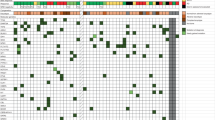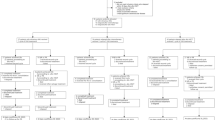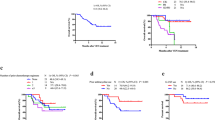Abstract
Venetoclax in combination with intensive therapies is explored in both the upfront and relapse/refractory (R/R) setting, and available data suggest that such regimens are effective albeit with added hematological and infectious toxicity. We conducted a multicenter retrospective cohort study of patients with acute myeloid leukemia (AML) treated with venetoclax in combination with FLAG-IDA protocol. Twenty-five patients were included in this analysis (median age 53.4 years). Most patients were treated for R/R AML (n = 24, 96%) with a median of one (range 0–3) previous lines of therapy and 44% of patients (n = 11) having prior allogeneic hematopoietic cell transplantation (HCT). Median follow-up was 10 (range, 4–26) months. Platelet and neutrophil recovery were observed at a median of 31 (95% CI 17.6–38.3) and 23 (95% CI 20–28) days, respectively. The most common adverse events were infectious (blood stream infections, 48% and invasive fungal infections, 32%). Thirty-day mortality was 12%. Composite complete remission (CRc) was 72% for the entire cohort and 91% in patients treated for post-HCT relapse. Incidences of relapse-free and overall survival at 12 months were 67% (95% CI 58–76%) and 50% (95% CI 31–69%), respectively. Real-world data show that the addition of venetoclax to FLAG-IDA protocol is effective in patients with high-risk AML, most notably in the post-HCT relapse setting. Prophylaxis and surveillance for infections are crucial.



Similar content being viewed by others
References
Sasaki K, Ravandi F, Kadia TM, DiNardo CD, Short NJ, Borthakur G, Jabbour E, Kantarjian HM (2021) De novo acute myeloid leukemia: a population-based study of outcome in the United States based on the Surveillance, Epidemiology, and End Results (SEER) database, 1980 to 2017. Cancer 127:2049–2061
Lancet JE, Uy GL, Cortes JE, Newell LF, Lin TL, Ritchie EK, Stuart RK, Strickland SA, Hogge D, Solomon SR et al (2018) CPX-351 (cytarabine and daunorubicin) liposome for injection versus conventional cytarabine plus daunorubicin in older patients with newly diagnosed secondary acute myeloid leukemia. J Clin Oncol 36:2684–2692
Roboz GJ, Rosenblat T, Arellano M, Gobbi M, Altman JK, Montesinos P, O’Connell C, Solomon SR, Pigneux A, Vey N et al (2014) International randomized phase III study of elacytarabine versus investigator choice in patients with relapsed/refractory acute myeloid leukemia. J Clin Oncol 32:1919–1926
DiNardo CD, Jonas BA, Pullarkat V, Thirman MJ, Garcia JS, Wei AH, Konopleva M, Döhner H, Letai A, Fenaux P et al (2020) Azacitidine and venetoclax in previously untreated acute myeloid leukemia. N Engl J Med 383:617–629
Wei AH, Strickland SA Jr, Hou JZ, Fiedler W, Lin TL, Walter RB, Enjeti A, Tiong IS, Savona M, Lee S et al (2019) Venetoclax combined with low-dose cytarabine for previously untreated patients with acute myeloid leukemia: results from a phase Ib/II study. J Clin Oncol 37:1277–1284
Shimony S, Stone RM, Stahl M (2022) Venetoclax combination therapy in acute myeloid leukemia and myelodysplastic syndromes. Curr Opin Hematol 29(2):63–73. https://doi.org/10.1097/MOH.0000000000000698
DiNardo CD, Lachowiez CA, Takahashi K, Loghavi S, Xiao L, Kadia T, Daver N, Adeoti M, Short NJ, Sasaki K et al (2021) Venetoclax combined with FLAG-IDA induction and consolidation in newly diagnosed and relapsed or refractory acute myeloid leukemia. J Clin Oncol 39:2768–2778
Döhner H, Estey E, Grimwade D, Amadori S, Appelbaum FR, Büchner T, Dombret H, Ebert BL, Fenaux P, Larson RA et al (2017) Diagnosis and management of AML in adults: 2017 ELN recommendations from an international expert panel. Blood 129:424–447
Cheson BD, Bennett JM, Kopecky KJ, Büchner T, Willman CL, Estey EH, Schiffer CA, Doehner H, Tallman MS, Lister TA et al (2003) Revised recommendations of the international working group for diagnosis, standardization of response criteria, treatment outcomes, and reporting standards for therapeutic trials in acute myeloid leukemia. J Clin Oncol 21:4642–4649
Donnelly JP, Chen SC, Kauffman CA, Steinbach WJ, Baddley JW, Verweij PE, Clancy CJ, Wingard JR, Lockhart SR, Groll AH et al (2019) Revision and update of the consensus definitions of invasive fungal disease from the European Organization for Research and Treatment of Cancer and the Mycoses Study Group Education and Research Consortium. Clin Infect Dis 71:1367–1376
Teh TC, Nguyen NY, Moujalled DM, Segal D, Pomilio G, Rijal S, Jabbour A, Cummins K, Lackovic K, Blombery P et al (2018) Enhancing venetoclax activity in acute myeloid leukemia by co-targeting MCL1. Leukemia 32:303–312
Stone RM, DeAngelo DJ, Letai AG, Stewart JM, McGinnis M, Brown F, Fell G, Flammand Y, Konopleva M, Garcia JS et al (2020) Maximal tolerated dose of the BCL-2 inhibitor venetoclax in combination with daunorubicin/cytarabine induction in previously untreated adults with acute myeloid leukemia (AML). Blood 136:40–41
Kadia TM, Reville PK, Borthakur G, Yilmaz M, Kornblau S, Alvarado Y, Dinardo CD, Daver N, Jain N, Pemmaraju N et al (2021) Venetoclax plus intensive chemotherapy with cladribine, idarubicin, and cytarabine in patients with newly diagnosed acute myeloid leukaemia or high-risk myelodysplastic syndrome: a cohort from a single-centre, single-arm, phase 2 trial. Lancet Haematol 8:e552–e561
Chua CC, Roberts AW, Reynolds J, Fong CY, Ting SB, Salmon JM, MacRaild S, Ivey A, Tiong IS, Fleming S et al (2020) Chemotherapy and venetoclax in Elderly Acute Myeloid Leukemia Trial (CAVEAT): a phase Ib dose-escalation study of venetoclax combined with modified intensive chemotherapy. J Clin Oncol 38:3506–3517
Kim K, Kantarjian H, Borthakur G, Takahashi K, Short NJ, DiNardo CD, Jabbour EJ, Chien KS, Daver N, Pemmaraju N et al (2021) A phase II study of CPX-351 plus venetoclax in patients with relapsed/refractory (R/R) or newly diagnosed acute myeloid leukemia (AML). Blood 138:1275–1275
Tiong IS, Dillon R, Ivey A, Teh TC, Nguyen P, Cummings N, Taussig DC, Latif AL, Potter NE, Runglall M et al (2021) Venetoclax induces rapid elimination of NPM1 mutant measurable residual disease in combination with low-intensity chemotherapy in acute myeloid leukaemia. Br J Haematol 192:1026–1030
Lachowiez CA, Loghavi S, Kadia TM, Daver N, Borthakur G, Pemmaraju N, Naqvi K, Alvarado Y, Yilmaz M, Short N et al (2020) Outcomes of older patients with NPM1-mutated AML: current treatments and the promise of venetoclax-based regimens. Blood Adv 4:1311–1320
DiNardo CD, Tiong IS, Quaglieri A, MacRaild S, Loghavi S, Brown FC, Thijssen R, Pomilio G, Ivey A, Salmon JM et al (2020) Molecular patterns of response and treatment failure after frontline venetoclax combinations in older patients with AML. Blood 135:791–803
Author information
Authors and Affiliations
Contributions
O.W, R.R, and B.N conceptualized and designed the study. O.W, R.R, and B.N analyzed results and wrote the manuscript. OW, A.F, L.S, M.Y, A.A, V.V, Y.M, S.S, O.A, Y.B, Y.O, and P.R. extracted data and critically revised the manuscript.
Corresponding author
Ethics declarations
Ethics approval
All procedures performed in studies involving human participants were in accordance with the ethical standards of the institutional and/or national research committee and with the 1964 Helsinki declaration and its later amendments or comparable ethical standards.
Informed consent
Informed consent was obtained from all individual participants included in the study.
Conflict of interest
OW reports receiving speaker Honoraria and past membership on Advisory Board of AbbVie. YM reports receiving speaker Honoraria and past membership on Advisory Board of AbbVie. AF, LS, MY, AA, VV, SS, OA, YBO, YO, PR and BN report no relevant conflicts of interest.
Additional information
Publisher's note
Springer Nature remains neutral with regard to jurisdictional claims in published maps and institutional affiliations.
Supplementary Information
Below is the link to the electronic supplementary material.
Rights and permissions
About this article
Cite this article
Wolach, O., Frisch, A., Shargian, L. et al. Venetoclax in combination with FLAG-IDA-based protocol for patients with acute myeloid leukemia: a real-world analysis. Ann Hematol 101, 1719–1726 (2022). https://doi.org/10.1007/s00277-022-04883-y
Received:
Accepted:
Published:
Issue Date:
DOI: https://doi.org/10.1007/s00277-022-04883-y




